Welcome to a new issue of the Journal of Runic Studies, the premier Malkioni publication for studies into the nature of Glorantha. If you haven’t subscribed yet, please consult with the spirit bound to the appropriate electronic page.
This week was of course holiday season, with some unusual low temperatures and snowfall here in Jrustela. While I was trying to wrap up some art for Jonstown Compendium customers and for my own projects, Jeff posted a lot of large notes on Facebook, with not much time left for me to analyze or research them in-depth… so apologies for the large blocks of quoted text this week!
God Learner Sorcery
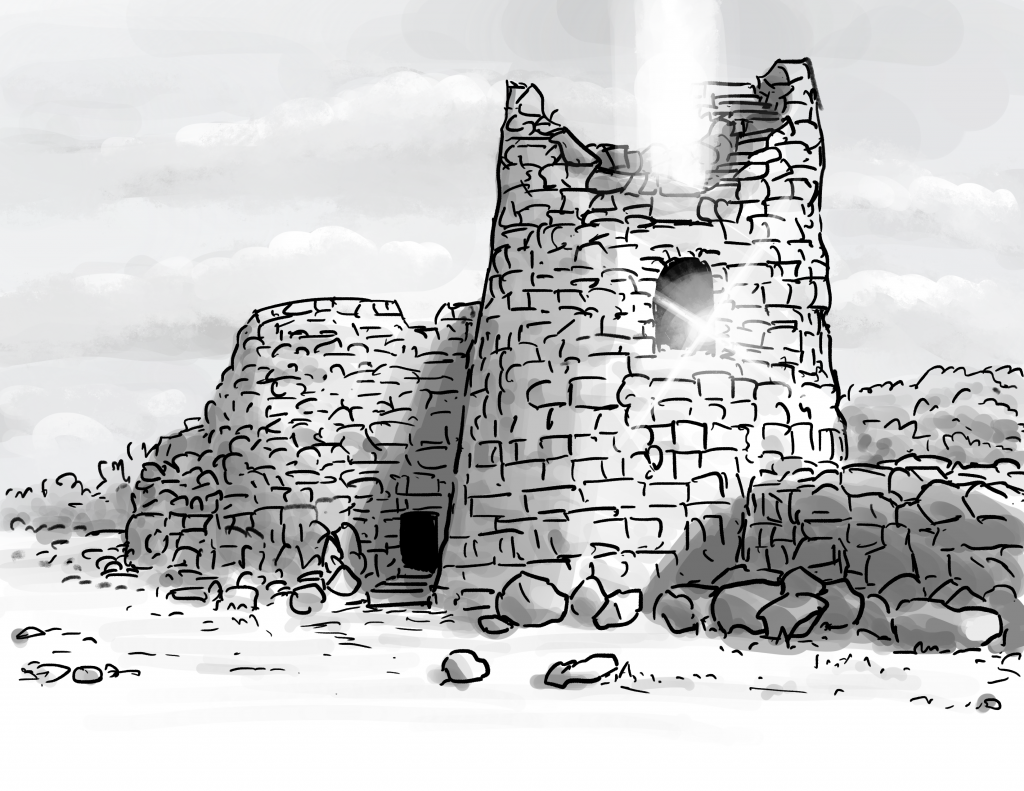
We are now occupying a nice little tower with a long history of previous occupants who have left behind documents, tablets, artifacts, and other kinds of junk. As we clean up and archive these things, we share the most interesting ones with you.
‘Tis the Season
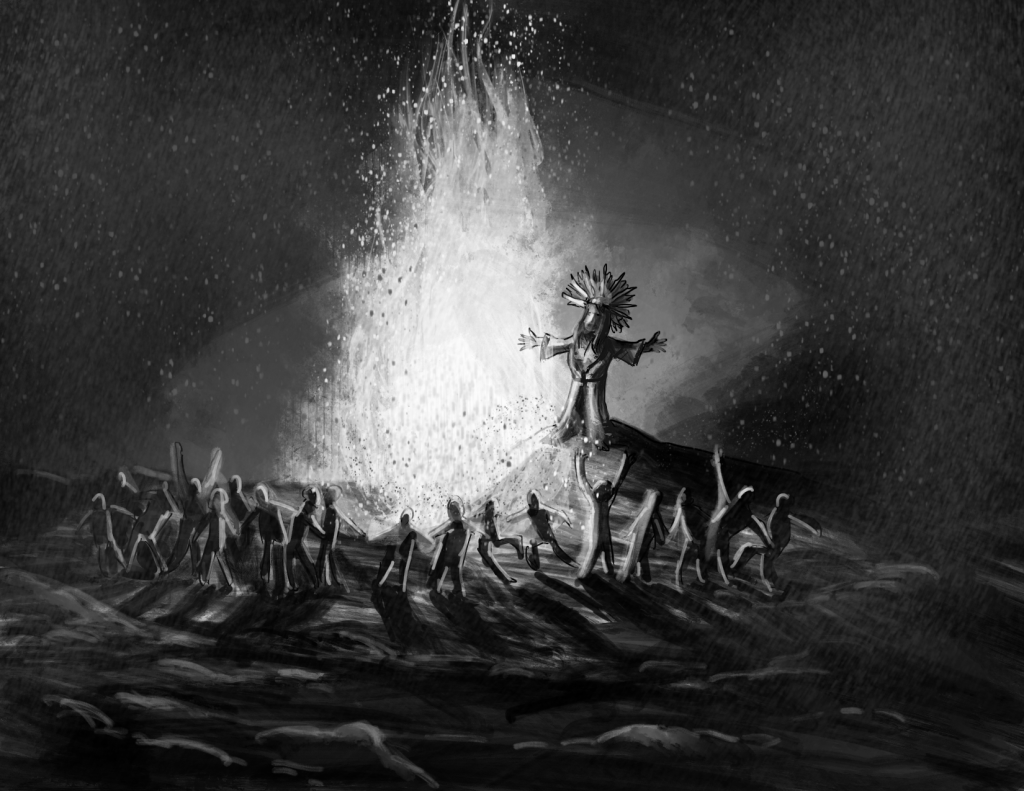
This week was the heart of the holiday season for most people who would be reading this kind of blog, so for all of you who celebrate anything, happy Sacred Time!
Now, the correspondence between Glorantha’s and Earth’s calendar has always been a bit iffy. Chaosium themselves have also given their Sacred Time Greetings this week, but in theory Sacred Time is a spring festival. The Gloranthan winter solstice happens in the penultimate week of Dark Season, as Ian Cooper explains, and as marked in the Glorantha Calendar and the Guide… But hey, I don’t see anybody getting two weeks off in spring to get drunk and eat piles of meat with their whole families! So I guess that when it comes to Earth/Glorantha correspondence, we have to pick between cosmological correspondence and cultural correspondence? Which would you pick?
Review: RuneQuest Starter Set
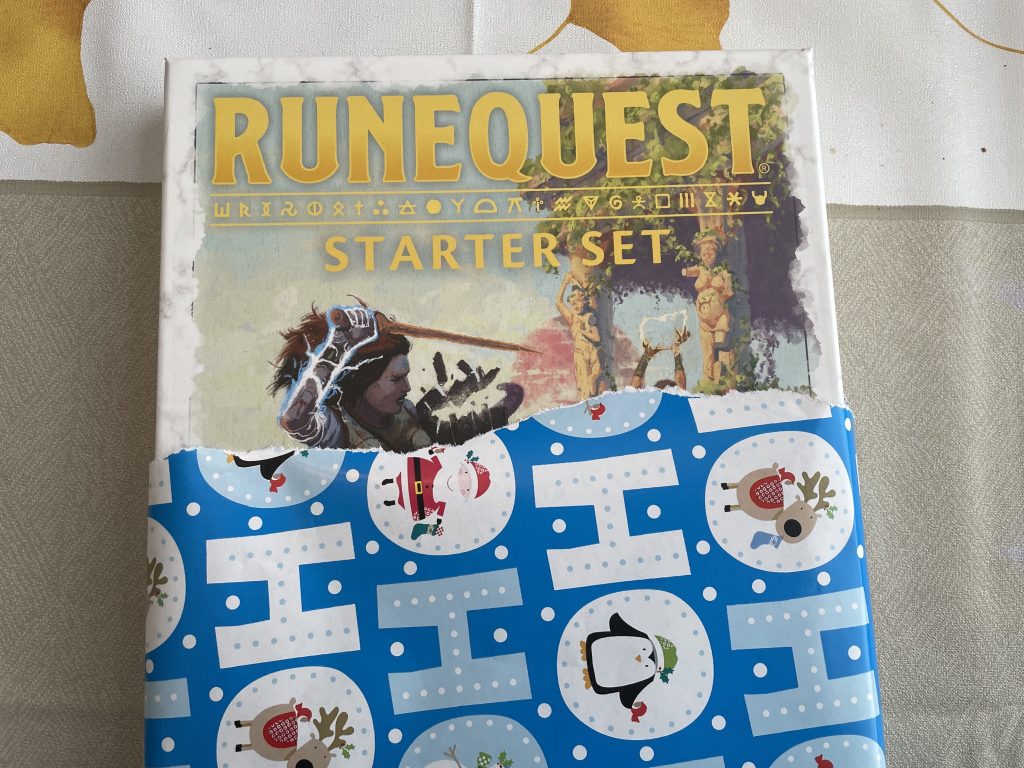
Did you think we would not start writing reviews of Gloranthan products? Well, to be frank, we weren’t sure either… but the pandemic holidays brought me some free time:
The RuneQuest Starter Set has already been reviewed many, many times, but since I have already gifted it three times this holiday season (yes, to my unsuspecting players), its merits and faults have been on my mind… and what kind of a Glorantha focused website would we be if we didn’t have some reviews? We’re just slow about writing them, being, like, two products behind schedule. But we are the God Learners, and you wouldn’t believe the kind of administrative puzzle we have to go through for approval of that kind of thing.
You can read this in-depth and, we hope, somewhat insightful or interesting review here!
We have linked to a whole bunch of other reviews in previous issues of the Journal already, but new ones keep coming! Lately these included Rolling Boxcars’ review, James Nicoll’s review, and Charles Dunwoody’s review.
Chaosium News

Here are this week’s Chaosium news!
Jeff Richard on Rambling about RuneQuest
Jeff Richard was interviewed on RPG Ramblings about RuneQuest and Glorantha.
Jonstown Compendium

The Jonstown Compendium is Chaosium’s community content program for all Gloranthan games, hosted on DriveThruRPG. Disclaimer: all the relevant links are affiliate links that hopefully will let us cover some of the hosting and maintenance costs for the website and podcast! Thanks for using them!
Glorantha Area Map: Kanthor’s Islands
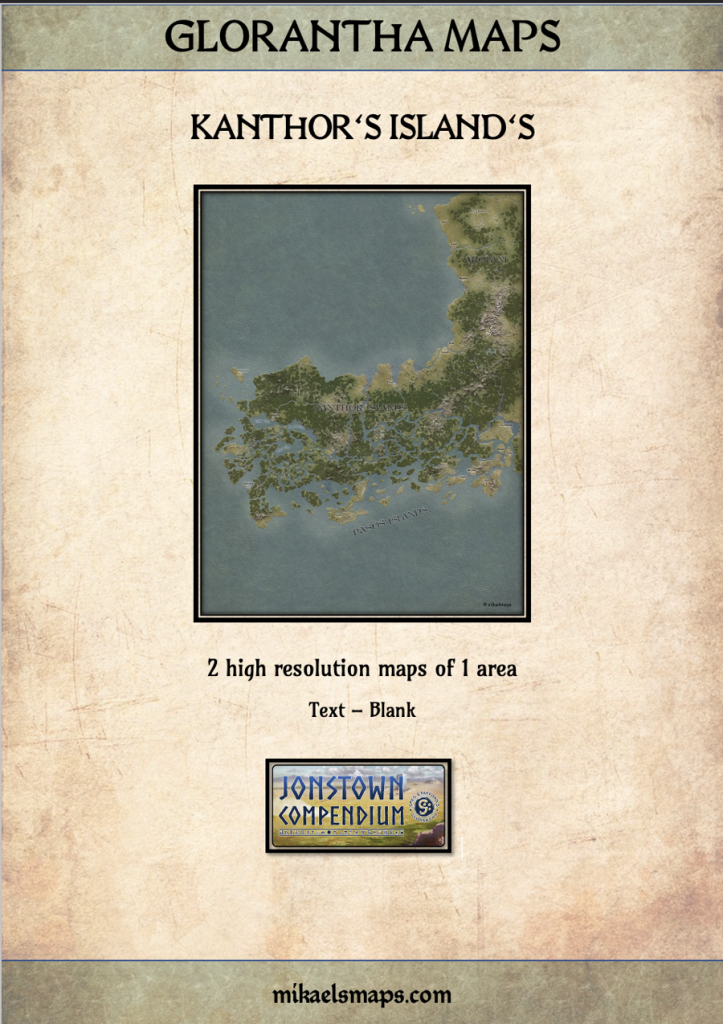
Mikael Mansen has been working on pimping up the Argan Argar Atlas’ maps, and doing a pretty good job at it! The first map is out on the Jonstown Compendium, and covers Kanthor’s Islands, in Seshnela. This is a pretty minimal product (two maps, one with text and one without), but it’s quite pretty and high resolution.
Mikael is also working on other maps, such as the Elf Sea area and other parts of Genertela.
RPG Imaginings Unboxes Armies & Enemies of Dragon Pass
If you want to see what the Print-on-Demand version of Martin Helsdon’s book looks like, here is RPG Imaginings flipping through it on camera!
Jeff’s Notes

Jeff Richard, the current mastermind on everything Gloranthan at Chaosium, is often posting notes and thoughts on the RuneQuest Facebook group. Here’s our curated list from the past week. A partial archive of these sources is compiled on the Well of Daliath.
Nochet and Other Metropolises
Jeff tries to remind us how densely populated cities like Nochet are, giving Bombay or Calcutta as a point of comparison.
Nochet’s population density averages somewhere around 18,000+ per square kilometer. That’s average – for every Sacred City garden that means somewhere else people are piled on top of each other.
Boldhome in comparison is a mere 3000 people per square kilometer, but it has plenty of empty space, which means that in the Pockets and the Main City, things get piled up.
In comparison, the population density of modern London is 5700 per square kilometer; modern Manhattan has a population density of 29,000 per square kilometer and San Francisco about 6600 per square kilometer.
While Nochet’s density is incredible, it isn’t unheard of for Earth’s bronze age cities either.
For instance, Alexandria in the last century BCE might have had 500,000 inhabitants, and even if only a fraction of those lived inside its walls (an area of about 5.3 square kilometres), that would still be way more dense than Nochet.
Another example is the ancient Greek city of Antioch (in modern day southern Turkey) is said to have peaked with at least 250,000 inhabitants around the same time frame (last century BCE), and potentially as high as 500,000 inhabitants. I’m having trouble figuring out its area (there’s the intramuros area and the general suburbian area, and some of that area was uninhabited rocky mountain), but even with a conservative estimate, it might have been twice as dense as Nochet.
Anyway, back to Glorantha:
Interestingly, although Boldhome averages only about 3000 people per square mile, Jonstown averages somewhere around 16,000 people per square mile. Which means it is built up more like Nochet than Boldhome.
Sheng Seleris, Shadow of the Lunar Empire
Jeff shares some thoughts about everybody’s favourite ruthless horse riding crazy nomad:
Sheng Seleris and his nomad army entered Peloria for the first time in 1375. Sheng Seleris was a celestial hero, whose horses could run through the sky, and whose companions were as pure and as merciless as the light of the sky.
As we mentioned in last week’s Journal, Sheng Seleris used his army’s superior mobility to force the Lunars into battles during Dark or Dying lunar phases. For almost 30 years, the Lunars knew “little more than defeat and humiliation”. Ouch.
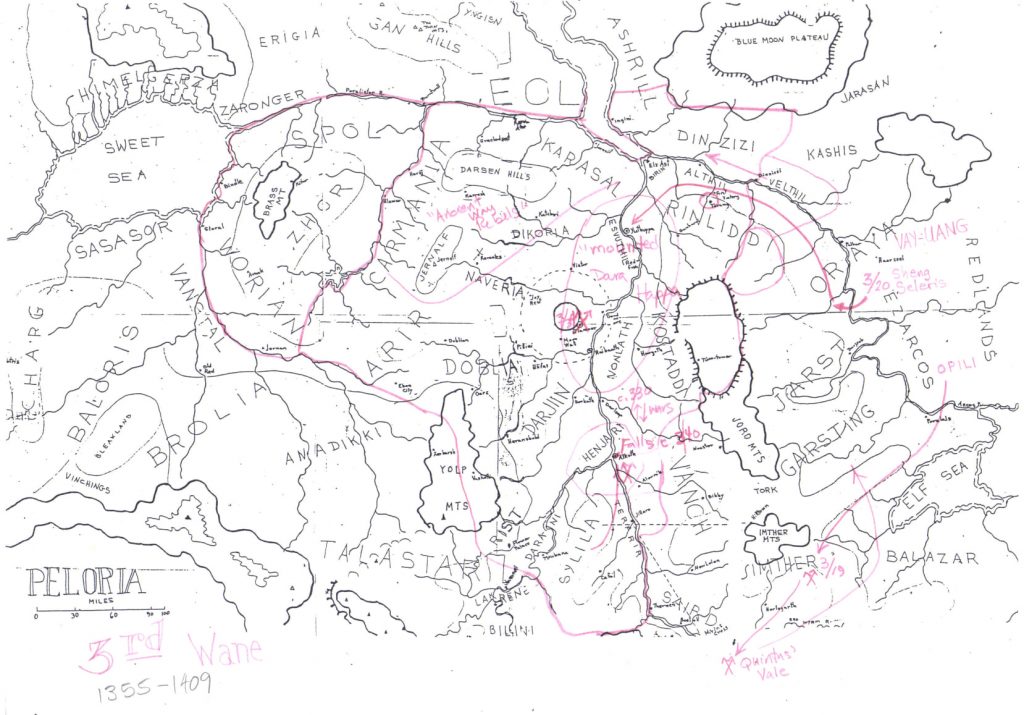
Jeff shared map sketches (above for the 3rd wane, later below for the 4th wane), but if you look at the nice colour versions in the Glorantha Sourcebook, you’ll see how the Lunar Empire got broken up in small pieces between 1355 and 1389. The Red Emperor really just had a few strongholds left (Glamour and the Silver Shadow area, Sylila, and the West Reaches).
The Red Emperor engaged in several magical contests with Sheng Seleris, but appeared to have lost them all.
I’m not sure what these magical contests would have been… Face to face battles, such as their “wrestling” in front of Glamour’s gates? Encounters during heroquests where the Emperor and the Nomad recognize each other? Something else? Either way, I’m pretty sure it was awesome.
Much of Peloria was overrun, and many cultivated areas returned to grassland. For FOUR GENERATIONS(!), nomadic herds roamed over the Pelorian grasslands. In some areas, city and town life continued, ruled over by Yelm-worshipping horsemen. Other areas paid tribute to whatever nomad chieftain demanded it, and submitted themselves to whatever other demands were made, in exchange for limited autonomy.
These four generations of nomadic supremacy ended in 1460, when Shen Seleris was finally defeated by a later Red Emperor. But let’s go back to the early 15th century first:
In 1409, the first Temple of the Reaching Moon founded. Within the “Glowline” formed by her temples, the Red Moon was always magically at Half Phase, which helped to mitigate the Lunar magical weakness that Sheng Seleris exploited. The Lunar Army knew a few successes against the lieutenants of Sheng Seleris, although whenever Sheng Seleris was present, the Lunars were badly defeated.
Reading the corresponding part of the Glorantha Sourcebook, my understanding was that three Temples of the Reaching Moon (and the Glowline they produce) was actually in effect several years prior to that, as early as 1397. My understanding here is that 1409 is the year during which the name “Temple of the Reaching Moon” was made official, and when the effect of the Glowline was revealed publicly.
Imagine the fun stories to tell and play in the years when the Lunars are building this magical infrastructure, but have to keep it secret from their enemies… could there be a Lunar sorcerer who, for reasons unknown, betrays the Red Emperor and designs a fatal flaw in the temples’ magical lattice, or something? A flaw that could be exploited by a small band of nomads who just have to lob an explosive into a small shaft to blow the entire thing up? Am I watching too many movies? Is my analogy completely wrong because the nomads are the ruling bad guys in this case? Am I asking to many questions in my own newsletter?
Anyway, you can check last week’s Journal for more discussion on the Glowline.
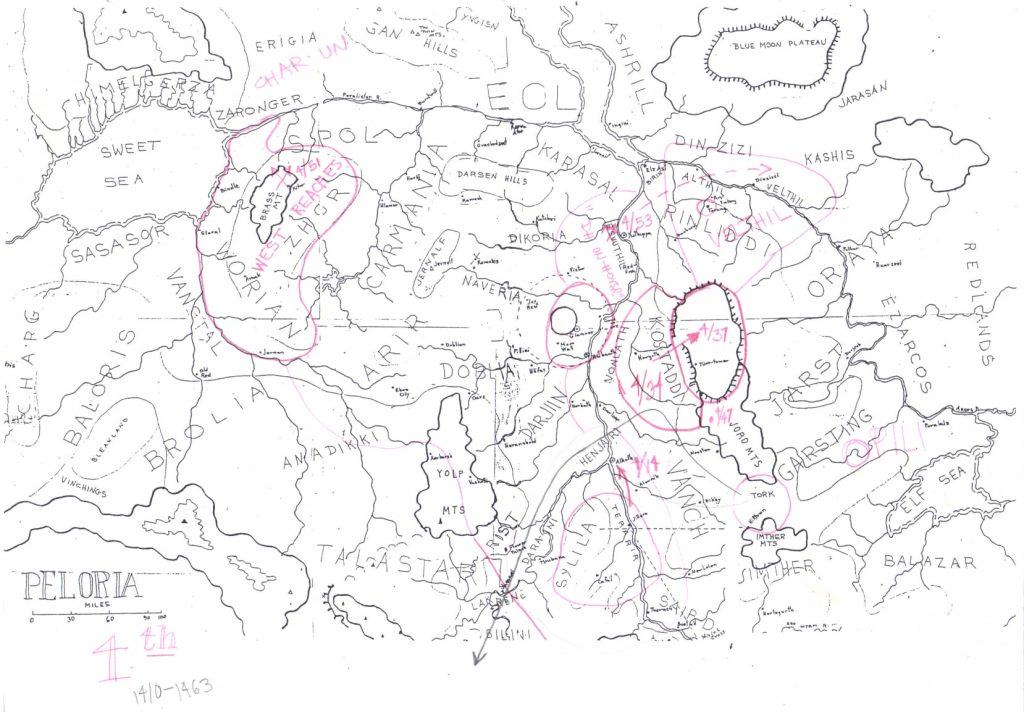
In 1415, Sheng Seleris killed the Red Emperor in a magical duel. This is the first time the Red Emperor is known to have died. He had ruled for over 150 years but now was gone. For 15 years, there was no emperor.
For those of you following at home, for some reason this is not mentioned in the Glorantha Sourcebook… I blame the Lunar Ministry of Truth and its “correction” of historical records. Thankfully, the Guide to Glorantha has a mention of the event. After that, you can follow Sheng Seleris and the Red Emperor’s battles in either books, but I like how it gets pretty epic at some point:
In 1442, Sheng Seleris defeated the Kralorelan Emperor and became a god. A new star appeared in the heavens. The remnants of the Lunar Empire shuddered before the Celestial Empire. The Red Emperor confronted Sheng Seleris and was killed again, and Sheng Seleris flew his elite warriors to the Red Moon to search for him. The scars on the Red Moon can still be seen by the naked eye.
That’s pretty bad-ass. But things started to change:
Sheng Seleris continued to search for the Red Emperor, and ravaged the land and mythology. He killed those who were formerly neutral in the conflict, and made a growing number of enemies. Even those who had once hated and feared the Red Goddess increasingly viewed her as the lesser threat.
In 1460, the Red Emperor returned (in a new form) and finally defeated Sheng Seleris in a magical duel the Battle of Kitor. Lunar propaganda claim this was a long-planned master scheme of the Red Emperor, but other accounts suggest it was more opportunistic and that many former enemies aided the new Red Emperor.
Over the next few years, the Lunar Army forced the now leaderless nomads to withdraw from the Lunar Heartlands into the Redlands. But the nomads were still powerful and a near-equal to the Lunar Army. The threat was not ended for another two generations with the Nights of Horror (1506), which destroyed both the Lunar Army and the nomads. The Lunar Empire raised a new army, but the nomads were forced deep into Pent.
The Redlands are immediately east of the Lunar Heartlands, with Pent far further north-east from there. The Nights of Horror was a two-day battle where most of 150,000 warriors and magicians were slain, Hon-eel (daughter of the Red Emperor) died, and Chaos and Dragons were involved. Exciting stuff. And yes, Chaos was summoned by the Red Emperor… I’m sure that using Chaos to finally get rid of the nomad bane was a big step at the time, but given its success at the time, the Lunars probably won’t think too much before they do it again if needed.
Sheng Seleris’ game of Whack-a-Mole against the Red Emperor exhausted the Celestial Emperor and turned formerly neutral (or even potentially friendly) forces into enemies. Ironically, this sounds a lot like what happened to the Lunar Empire in the Eighth Wane.
The Eigth Wane is of course the “current” wane, as per RuneQuest’s starting date.
Almost every institution we associate with the “modern” Lunar Empire except the Seven Mothers and the Red Goddess really is the result of the struggle with Sheng Seleris and the nomads. The Glowline. The Lunar College of Magic. The Cavalry Corps. The widespread nature of New Pelorian. Referring to each new Red Emperor as a “Mask” of the Red Emperor. And so on.
So before you think about the Lunar Empire, remember that it rose out of the ashes of a previous Lunar Empire, one nearly destroyed by Sheng Seleris. The Lunar Empire has known defeat and had to recreate itself out of the ruins.
The Seven Mothers Cult
Jeff wants to set the record straight about the Seven Mothers cult, which is sometimes pictured as imperialist colonial administrators similar to those of the 19th century British Empire. But they’re not thinking of themselves as “bringing civilization to the barbarians of Dragon Pass”, and don’t act in a condescending way to the cultures they are proselytizing in:
The Seven Mothers purpose is to prepare people to embrace the Red Goddess. Most people never become Illuminated, but the Seven Mothers creates an environment where Illumination can be welcomed and respected – not feared or killed. The Seven Mothers likes those things that like the Red Goddess, and it fights against those who would fight the Red Goddess.
In my campaign set in the 1610s near Alone, I gave a few glimpses of the Seven Mothers missionaries getting set up around the confederation: they are advocating inclusivity, telling all the kids they can be “whatever they want to be when they grow up”, hand out candy and free t-shirts at their worship ceremonies, advertise the tax cuts you get when you join them, and so on. They’re very nice people (at first glance), and I sort of modelled them after real-life cultists like Raelians or Scientologists.
Often Seven Mothers missionaries find themselves in cultures that are as wealthy, technically skilled, whatever, as the Lunar Heartlands. Carmania was wealthier, more developed, etc. than Rinliddi – that didn’t matter. Carmania threatened the nascent Red Goddess and needed to be defeated so that its population could be prepared to embrace her.
For most Seven Mothers cultists it is a universal goal – the Red Goddess needs to be embraced by the world so that we all can finally be healed. The Lunar Heartlands are in just as much need of healing as the barbarians.
See? They’re nice people! They’re looking after your well-being!
Now add to that a level of imperial chauvinism – that it is only right and proper that the Red Emperor rules the world and that Lunar/Dara Happan/Pelorian society is the only right and proper society and that everyone not of Lunar/Dara Happan culture is a benighted barbarian. This cultural chauvinism is always present but is also at odds with the Seven Mothers mission. It is sometimes suppressed (by enlightened provincial administrators like Phargentes, Moirades, Fazzur Wideread, or Sor-eel), but just as often it suppresses the Seven Mothers mission (e.g., Euglyptus the Fat, Tatius the Bright, Halcyon var Enkorth, etc.).
Well, you know, they’re people too, and they have their flaws. Still… free t-shirts! Come over!
These imperialists rarely justify their rule by saying they are building roads, aqueducts, whatever – because they aren’t! Maybe they introduce maize through the Hon-eel cult, if they remember to do that. They tolerate the Seven Mothers missionaries, but primarily they justify their rule because it is right and proper that the rule of the Red Emperor should be universally acknowledged. They are imperialists first and foremosts.
Remember that Sartar already has fancy roads, cool dwarf-built architecture, and so on… so although I love the Life of Brian references as much as the next guy, they don’t quite apply as much in the “new Sartar” described in the latest RuneQuest line.
The imperialists and the missionaries often work hand to hand, but also are often in tension. Many suggest that the closer to Mirin’s Cross, the more likely the missionaries get their way – the further away, the more the imperialists get their way. But enough exceptions exist to make this a dubious political maxim.
It sort of nice to think about because you could even show the difference between the Lunar soldiers, administrators, and tax collectors, and the Seven Mothers missionaries, with one getting obviously annoyed by the other. One wants to invade and control everything, the other wants to spiritually liberate everybody. That could generate some sympathy for the missionaries, and even lead to interesting alliances, stories, and even cult memberships…
Jar-eel the Razoress
What’s more bad-ass that Jar-eel’s nickname? Well, a Jon Hodgson painting for instance!
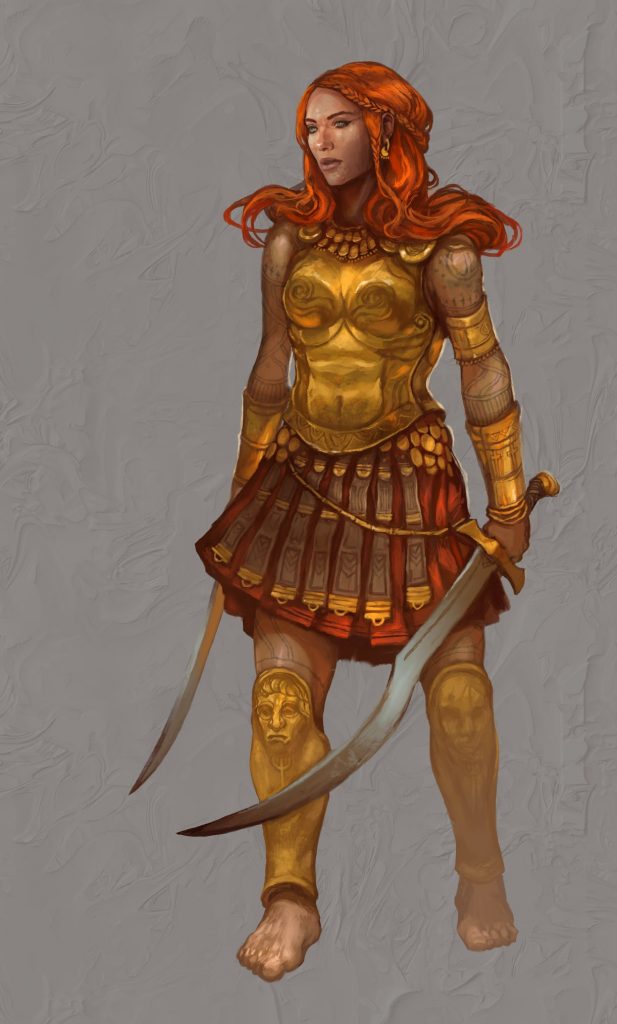
Arguably the mightiest hero in Glorantha at this time is Jar-eel the Razoress. She has loads of titles – Fourth Inspiration of Moonson, Incarnation of the Red Goddess in Time, daughter/lover/mother of the Red Emperor, poetess and musician, defeater of barbarians, etc. But let’s talk about HER for a moment.
Jar-eel was born in 1588 in Glamour and when she was only one year old she was part of the Legion of Infants that traveled over Fronela in Moonboats and thawed Syndic’s Ban. At ONE year old.
At eight, she was Illuminated and traveled to the Red Moon itself.
At fourteen, she was a leader of the elite warriors who sacked Boldhome.
When she was twenty-nine, the Temple to Jar-eel was consecrated in Glamour. The Moonsword cult already worships her. She dismembers Belintar, suppresses the White Moon Movement, and defeats the Voor-ash confederation. And so on, and so on.
[…] Jar-eel was born to incredible power and privilege and has achieved more.
She is not a ruler, but even the Red Emperor is often over-shadowed by his glorious “daughter”. She is a figure like Krisha in the Mahabharata – operating at a different plane of existence than those around here. Let her drive your chariot, and she’s likely to Illuminate you on the trip across the battlefield!
“The energy which the gods are endowed with is indeed great, but mine is greater.” – from the Song of the Razoress.
She so incredible that Jeff thinks she’s probably the most famous person alive if you play in the standard timeline. She is “revered within the Lunar Empire, feared in the Redlands, Holy Country, Dragon Pass, and Prax”.
And Jar-eel embraces contradictions. She is both notably merciful and notoriously cruel. She loves, but kills without hesitation or remorse.
Jar-eel is a patron of the arts, a musician, and a poetess. She debates with the White Moon Movement and many of those who witness her renounce their errors and return to the Red Moon. Those who reject her words are killed.
I picture these “debates” are incredibly tense scenes in the Lunar halls, like a magical and heroquesting version of the movie Ridicule, where “simple” discussions and witty exchanges in the French King’s court can lead to extremely serious, violent, and deadly outcomes later on.
And they are true debates, magical events where she invites the leaders of the WMM to prove their claims. Jar-eel devastates them so badly that some bleed from the eyes as their tears run out.
Jar-eel, not the Red Emperor, is the real Elvis of the Lunar Empire. She walks into a room and everyone – even gods and spirits – stops to look at her. She’s that beautiful, that charismatic.
So whenever you think of the Lunar Empire, always keep in mind the presence of Jar-eel, for good or ill. Her charisma overwhelms that of the Red Emperor or Great Sister. She is a rock star, movie star, star athlete, and so much more.
Of course, she can juggle the duality of Moon and Chaos without any problem:
As for Chaos, Jar-eel accepts it as any Red Goddess illuminate should. Jar-eel has ridden the Crimson Bat, unaffected by its Chaotic abilities. I’ve heard stories that she has even allowed civilised broo to join the Moonsword regiment, as long as they maintain discipline and standards.
Jar-eel is said to be inhumanly graceful and agile, and dances with her two swords to cut down entire regiments. Afterwards, she is famed for composing poems. One famous poem compares bloodshed in battle to a field of red roses, with the impression that both are equally expressions of beauty.
After reading all this, I’ve been wondering whether Jar-eel actually gets more magic from her Hero Soul than from her worship of the Lunar deities?
For than a generation Jar-eel has been a – and more often THE – dominant light in the Lunar sky. Most accounts place her far above the mundane and magical machinations of her Eel-ariash kin, who nonetheless have gained tremendously by her presence. Even the Red Emperor might have second thoughts before acting against the family of the Fourth Inspiration of Moonson. Imagine how the other satraps and imperial nobles must feel!
The Great Compromise
We know that the Great Compromise was created after the Gods War to separate the Gods from the mortals, binding the latter to Time. Jeff adds a few details: three “universal rules” that the deities agreed to.
First, they would concede previous claims, and mutually agree to define themselves as they were, making no further attempts to interfere with the realms of other deities. They shared Nature among themselves. No longer would Orlanth strive to be Lord of the Underworld, nor Yelm to be King of Middle Air.
Second, all the goddesses and gods accepted to include within their being all which had occurred to them before, each event being in appropriate measure. Thus Yelm would spend half his time in the Underworld, and half in the upper world.
They agreed too that no deity would directly manifest themselves into the world, but instead work through Nature, worshippers, proxies, avatars, and incarnations which would be inferior to the true deity.
I think that most deities took it the same way Captain Barbossa takes the rules of parley: “it’s more what you’d call guidelines than actual rules”…
The Red Goddess in Time
Speaking of violating the Great Compromise, let’s look at the Red Goddess:
She is a Greater God who appeared during Time, embraces Chaos, and her very existence violates the Cosmic Compromise. Many of the Old Gods refused to acknowledge her because of this – her victory at Castle Blue forced them to acknowledge her power, and many now accept and even embrace her (most significantly Yelm). However, several of the most powerful gods remain her resolute enemies (Orlanth most prominently, but also Storm Bull, Valind, Kyger Litor, Humakt, Eurmal, and Zorak Zoran). Many others (Aldrya, Magasta, Yelmalio, and the Malkioni) remain hostile to the Red Goddess.
The Battle of Castle Blue was a year-long affair that’s a bit convoluted, but as far as I understand the Red Goddess (who was not a deity yet) triggered it as a way to “prove” herself, drawing in all the Old Gods and forcing them to accept her in the God Time. That’s when she truly became the Red Goddess.
Through Illumination, the initiates of the Red Goddess are liberated from the reflexive fear of Chaos and oblivion. They believe that by following along the path of the Red Goddess, they can thread this needle and embrace ego annihilation as a means of liberating the true self. Enemies of the Lunar Way point out that in many cases this path to “ego annihilation” results in an even greater false self – Gbaji. The parallels with Nysalor and the Broken Council are there for all to see, although many Lunar apologists claim that with the Red Goddess’ aid, Nysalor has now defeated Gbaji (Sheng Seleris). Others claim that at the Shadows of the Empire, Arkat or Arkats are being formed once again.
More disturbingly is the rise of the Lords of Terror with at least the tolerance of the Red Goddess. The Lunar Empire sponsors the Chaos demon called the Crimson Bat, accepts worship of Primal Chaos, and is known to cooperate with such Chaotic cults Krarsht, Mallia, Thed, and Vivamort against the mutual foes. Within Chaos strongholds such as Dorastor, Snakepipe Hollow, and the Footprint, the Lords of Terror have awakened.
Some mystics claim there is uncertainty at the core of the Red Goddess’ existence that makes it impossible to resolve whether she is a deity of Chaos or of the Cosmos, or even that she is both simultaneously. This uncertainty and ambivalence is a key driver in the cataclysm later known as the Hero Wars.
Here, frankly, I’m not sure it matters? When it comes to the people of Glorantha, they probably judge her on her actions and the actions of her followers: she’s crazy, rides a giant Chaotic weapon of mass destruction, and says you can reach illumination and be one with the cosmos. Or something like that. Classifying deities is the purview of the God Learners and other intellectuals. Others just know that their gods hate the Red Goddess, and that’s enough for them?
It is perhaps inevitable that the Hero Wars ultimately is conflict between the two most complex of Gloranthan deities – the Red Goddess and Orlanth. As we know, Orlanth is both a Destroyer and the Upholder of the Cosmos. Like Shiva, he destroys and creates. He plunged the Cosmos into Darkness when he slew Yelm, but his Lightbringers Quest was the key to the preservation of the Cosmos.
Memory of the Elder Races
Jeff muses about the memory of the Elder Races. For instance, a lot of elves will remember the Inhuman Occupation, and be unable to differentiate much between the various humans who came back into Dragon Pass. The “political squabbles” between the Lunars and the Orlanthi doesn’t mean much to them… this means you can have any elf show up on any side, or be an annoying road block to both sides!
And some elves have been replanted or reseeded, and recall events from the Second or even First Age.But this memory also means that old feuds and betrayal are not forgotten. Humans are a secondary concern – the other Elder Races are existential threats.
Ok, on to the Uz. Mistress Race trolls are immortal, but there’s only very few of them around:
Most Mistress Race Trolls were born in Wonderhome, before the Dawn. The race was already diminishing in the First Age before the Curse of Kin. Arkat and his companions were the last Mistress Race Trolls born in Time, until recently.
Arkat is considered a Mistress Race Troll? Huh, interesting (disclaimer: I don’t know much about Arkat). And “until recently”? Ok, who got some big babies?
Some are many thousands of years old. They barely recognize the dark trolls as their descendants – the trollkin are hated mockeries. The Mistress Race remember Osentalka! They remember the Broken Council! They remember the betrayal of the dwarves and elves, the fickleness of the dragonewts.
A Mistress Race Troll should be a terrifying encounter – likely to occur only in the deepest Darkness of a troll stronghold. She is a dark, rumbling thing, constantly hungry, utterly without mercy, and those with Second Sight will wish they did not. Sure she has dozens of Rune points but most have also wrested strange powers from gods and spirits. Your human tribe, kingdom, or empire is irrelevant to her, unless she learns that it is tied to something she experienced and still cares about.
The Deadwood
Jeff is talking about something we just explored in my campaign: the Deadwood, up in the Indigo Mountains near Alone… and not to be confused with the Woods of the Dead, which is also near Alone, but is completely different! (seriously, Greg, what the fuck)
Deadwood was the site of an Early Third Age conflict between elves and trolls. After the Dragonkill War killed all the humans, the elves tried to reclaim the Pass from 1120 to 1150. Reinforced by Brown Elves from the Old Woods, the Stinking Forest expands to the Indigo Mountains (as well as down the Dragonspine).
The Elves planted a marching forest to try to break the back of the trolls. That’s why the trees go so far up the mountains. To the elves’ horror, the trolls summoned Gorakiki Beetle and swarms of bark-boring beetles killed trees and elves alike. The trolls awakened the Indigo Mountains and an eruption killed the trees inside the Indigo Mountains, and then the trolls released the beetles on the rest. The trolls were also aided by spirits and by the half-trolls of the Ivory Plinth.
This broke the back of the Aldryami attempt to reclaim Dragon Pass. The trolls keep the dead trees standing as a reminder to the elves what will happen if they try again. The angry ghosts of the Aldryami still haunt Deadwood.
I didn’t have angry elf ghosts in my Deadwood (maybe I’ll add them next time I run the adventure!) but I went a bit farther, trying to explain why the trolls didn’t unleash these bark-boring beetles onto other elven armies: I turned it into a unique type of beetle that a Gorakkiki Rune Lord got only through advanced heroquesting… and paid a steep price for.
I’m sure you can also explain it more simply by the fact that the elves kept their distance anyway, and that Dragon Pass got repopulated with humans quickly after, which created a lot of buffer between the two warring Elder Races.
Now this nicely illustrates the conflict between the Elder Races. Always remember that the Elder Races usually view all humans as the Lesser Enemy. The True Enemy is the other Elder Races. And they have very good reasons for this.
This I got right: in my adventure, both the trolls and the elves have no regard for the humans of the Alone Confederation tribes, using them as cannon fodder or meat shields in their centuries-long battles… still, my players sided with the elves in this case! Go figure!
Random Events
Jeff shared a snippet of the upcoming Dragon Pass Campaign (or whatever it will be called): a few tables for random events at the clan, tribe, and entire region levels! This is a really nice treat as far as I’m concerned… Here they are, lightly formatted for your enjoyment.
This kind of table is nice for rolling or picking an idea for a new adventure or a complication in an existing one. Jeff also adds:
This is intended to be out of the ordinary events. So stuff like a caravan shows up is an ordinary activity. Or the stuff that normally happens at assemblies, militia musters, or seasonal holy days. That stuff happens according to the calendar – or often enough that it is pretty darn predictable.This is the unpredictable stuff that happens, and screws with player plans!
A Summary of Argrath’s Life to 1627
Jeff shared a short document he and Greg worked on to get an outline of Argrath’s life path until 1627:
Born on Starfire Ridge to the Colymar Tribe
Maniski killed in fall of Sartar
Yanioth killed (by Telmori?)
Initiated to Orlanth
Outlawed from Starfire Ridge
Made slave among Bison Riders
Discovered White Bull, founded secret society
Became Wind Lord of Orlanth, gained a draconic entity as an allied spirit
Adopted name Garrath Sharpsword and resided in New Pavis
Quest of the Drinking Giant’s Cauldron
Giant’s Cradle
Met Harrek
Circumnavigated the World, many adventures
Battle of Pennel Ford
Was lover of Queen Samastina
Left for Prax, gathered White Bull society and summoned Jaldon Goldentooth
Liberated Pavis
Liberated Corflu
Defeated at Hender’s Ruins
Founded first Magical Union, gained Dragon Teeth
Defeated Lunar Army in Far Place, liberated Alda-Chur
Became Prince of Sartar
And some peek behind the scenes:
When we were writing this, we looked at the early years of Alexander and Napoleon Bonaparte – Argrath’s manic activities seem pretty reasonable in comparison!
But Argrath has the farthest to travel in order to become a peer of the likes of the Red Emperor, Gunda the Guilty, Beat-Pot, or Sir Ethilirist.
The Sisters of Mercy
I thought that “Sisters of Mercy” was just a term for Chalana Arroy hospital staff, but apparently they’re also actual daughters of the goddess? I don’t know, I haven’t read much of the Stafford Library’s stuff. But Jeff knows of course!
The Sisters of Mercy are the daughters of Chalana Arroy, adopted or otherwise. Malamse, Oronio, and Amprefesne are the three holy Sisters most often called upon, but there are many others. Many living High Healers are often accounted among their numbers and the title “Sister of Mercy” is a common name for High Healers in Dragon Pass.
They live in an invisible nunnery whose exact location or dimensions are unknown. Some claim that it is as large as the world, encompassing all of the cosmos within its walls. This is, however, untrue as proved by the Sage Elad Kramdnil during the reign of Prince Salinarg. He showed that the Sisters are met wherever the old Empire of the Wyrms Friends was dominant, and he was the first to state that they should be considered remnants of that lost empire. This lends credence to the belief that the Empire was not totally corrupt, as such remnants as the Tusk Riders and Delecti would suggest.
The Sisters of Mercy is the subcult most commonly worshiped in Dragon Pass and Prax. It provides the Refine Medicine spell. The center of the subcult is the Nunnery in Dragon Pass.
You can find the Refine Medicine spell in the Red Book of Magic, along with all the rules for finding and processing healing plants!
The Middle Sea Empire and the God Learners
I know we’re supposed to be the God Learners and I should know about this, but I’m mostly ignorant about the Middle Sea Empire, aka the Jrusteli Empire, the farthest-spanning nation in the history of Glorantha. Jeff says:
Its core was city-states of the island-continent of Jrustela who were tightly allied with the kings of Seshnela, and in 789 they formed together the Middle Sea Empire.
Seshnela and Jrustela were ruled by Hrestoli Malkioni, although they had significant Theyalan influences, particularly in Jrustela. The Umathelan Coalition was part of the original alliance, and in Pamaltela, the Empire expanded to conquer Fonrit, Laskal, and Jolar (where it was known as the Six Legged Empire).
To help place things geographically, Jeff shared another map sketch, and if you want the pretty version you can look into the Glorantha Sourcebook or the Guide, of course.
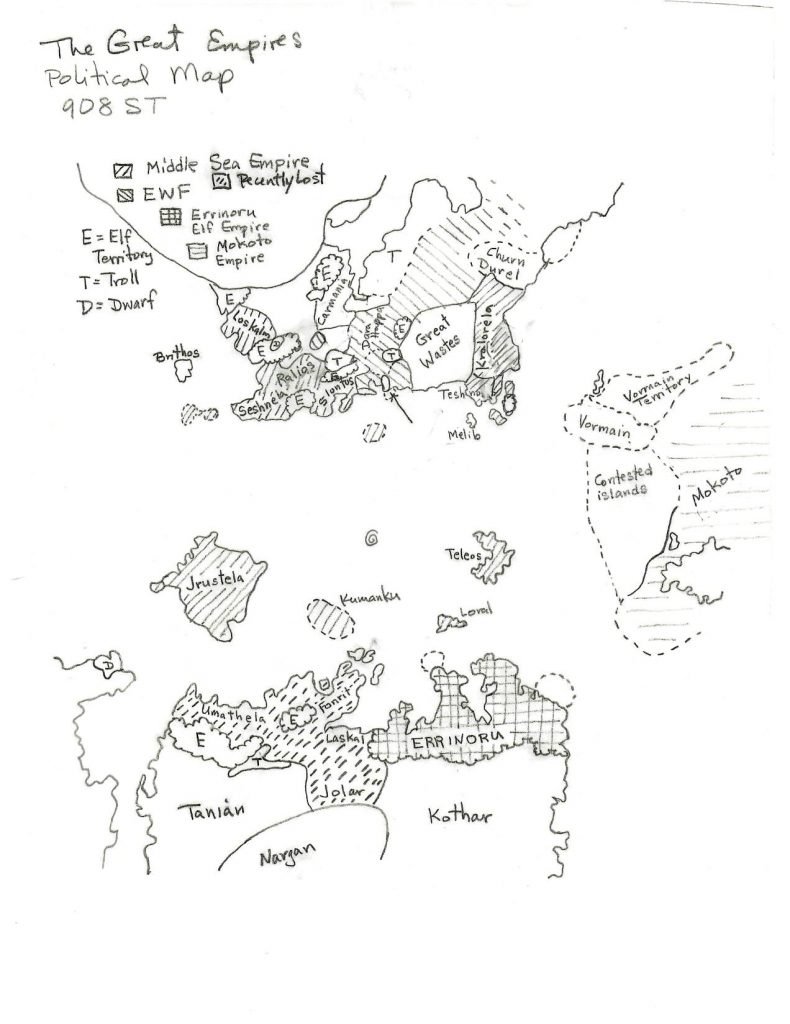
Slontos was conquered by the Middle Sea Empire, and it formed a borderland between the Middle Sea Empire and the krjalki of the Empire of the Wyrms Friends, with its dragons and trolls. Akem in Fronela was also a stronghold of the Empire, which later expanded to rule much of Frontem (Loskalm).
The Middle Sea Empire ruled Teshnos, Teleos, and Loral and included the New Dragon Ring of Kralorela.
With the core of the Middle Sea Empire being a bunch of Malkioni sorcerers, and the Empire of the Wyrms Friends being more theistic, I don’t imagine they got along philosophically speaking at least.
The Dark Empire of Ralios was conquered in 740, and the Arkati secrets taken from the Stygian Archons formed the basis of the Mythic Maps of the God Learners, which enabled their great conquests.
Ok so here we have the remnants of Arkat’s empire, with some of the secrets he got from his awesome heroquesting and battling against Gbaji a couple centuries prior. The God Learners plunder that and start piecing things together.
The Mythic Synthesis Movement enabled the God Learners to develop the Monomyth, a holistic understanding of all the mythologies of their allies and subjects. Cults such as Chalana Arroy, Issaries, Lhankor Mhy, and Wachaza were deliberately encouraged and spread by the God Learners, although the ruling caste was largely Hrestoli Malkioni, at least at first.
And this is something worth keeping in mind – the Middle Sea Empire was not a Malkioni missionary movement. Each new culture it encountered or conquered had secrets and insights which were synthesized into the Monomyth, and the God Learners came the closest of any mortals to seeing the “whole mythological picture”. Their insights were adopted by their enemies, for example, Jrusteli information and trade filtered into Dragon Pass, where it was quickly appreciated by the rulers and used in tandem with their new draconic magics.
The Empire of the Wyrms Friends
And of course now that we talked about the Middle Sea Empire, we have to talk about the EWF. Jeff shared this abridged text from the upcoming Cults books:
Two great schools of investigation existed in the Second Age. One originated in the far east. It became a popular mystical religion in Dragon Pass and created new horizons of magic. The political form of this religion was the Empire of the Wyrms Friends, who had learned powerful secrets from the dragons and enjoyed the support of the dragonewts and the rest of dragon-kind. This splendid and colorful age combined many parts of many ideas to make a new wholeness to face the world.
The ruling humans became progressively more interested, fascinated, and enmeshed in the strange draconic magics. These left-handed pathways offered exotic and strange powers, whose effects could be exceptionally devastating when manifest in the physical world. In 826, the Empire of the Wyrms Friends—or the Third Council—was established to rule over the material interests of the leaders of the draconic movement. The rulers began a long and intense ritual that was expected to take generations to conclude.
During the development of the Grand Ritual, the fortunes of the Empire of the Wyrms Friends grew. Armies of dragonewts and trolls led by Lightbringers who rode dragons and wyrms conquered much of central Genertela. The barbarians of Prax were defeated, and the Shadowlands and the Storm Hills paid heavy tribute rather than fight. Jrusteli information and trade filtered into Dragon Pass, where it was quickly appreciated by the rulers and used in tandem with their new draconic magics.
Here we are catching up to what we had in the previous note (above), where the Mythical Synthesis Movement was used to actually strengthen the religious understanding of the EWF.
Also, if you want to ride dragons into battle, here is where and when you can do it! (the “Lightbringers” in this case are, I believe, Runemasters of Lightbringer deities)
In 889, the Third Council demanded to be worshiped in place of the traditional Lightbringer deities. Immense energy and power were needed to sustain the Grand Ritual. The dance of the gods in the early stages of the ritual provided much of the energy used to expand the Third Council’s domain. However, in the latter parts of the spell, more and more power was to be provided by the population, who were at the same time growing distant from their increasingly-demanding Council. The Council, deep in spectacular meditation, was either unaware of the dissatisfaction, or unable to break their concentration to do anything about it.
[…] The Pelorian peasants welcomed Carmanian spirits into their newly-built temples, and burned the images of the Third Council members. The dark trolls of the Blue Moon Plateau killed and ate the dragonewts that garrisoned Peloria. Dara Happa rebelled and Prax fell. Orlanth Rex reestablished his primacy over the gods and slew his Third Council imposter.
Another member of the Third Council awoke to the threat of the barbarian hero Jaldon Goldentooth, and directed some divine energies to aid the beleaguered Six Sisters upon the border with Prax. The tattered remains of the Empire gained heart, and members of the Council took form and descended to the earth to aid their people.
Such was the cause of their downfall, for in aiding their fellow mortals, the Council abandoned their unfinished ritual. The Grand Ritual was left with insufficient leadership among those few Council members who did not return to earth. The magic lost direction, and its release was directed first against its makers and then against their followers.
As always, Jeff adds a few insights in follow-up comments:
So imagine the EWF as “something like” the old World Council of Friends, BUT the Orlanthi are clearly the dominant group and they are firmly allied with the dragonewts and other draconics. And their rulers are in deep conversations with the dragons, seeking power and understanding. Eventually, that ruling council concludes that they are gods and should be worshiped as such.
So we have this Orlanthi empire that dominated central Genertela. Now wait you might say – the Third Council insisted on being worshipped as gods! How can you say they were Orlanthi?
Simple – the rulers established themselves atop the traditional cults and allocated more and more the worship energies to the great great ritual of the Proximate Realm. But the base was always the traditional cults at least until near the end.
But this mighty empire – which steamrolled Dara Happa while fighting off the Middle Sea Empire – lurks behind Orlanthi history.
“We hate dragons and would never cooperate with them.”
“Perhaps that is true. But our ancestors did, and they ruled the world.”
I guess that’s Argrath’s marketing pitch?
So where we see the EWF dominant, we also see the Lightbringers Pantheon (Orlanth, the other Lightbrinters, Ernalda, Humakt, etc). The very top of the society are engaged in mystical experimentation, but most people at most dabble in this and worship their Theyalan gods as led by their priests (who are increasingly engaged in mystical experimentation).
This is of course a gradual process. In 826, we might have a ruling council allied with the dragonewts and dragons, who are supported by the priests who seek to maintain the Proximate Realm, and the rest of society just do what they have always done with a little extra for the Proximate Realm.
By 889, those rulers are now gods and demand to be the primary focus of worship and are supported by the priests. The rest of society is torn about this, but the rulers are as powerful as gods, are backed by dragonewts, dragons, and many mercenaries. And so things erupt in violence and peoples who might have supported the original Empire of the Wyrms Friends now oppose it. And people who did oppose the original EWF, now support it.
And:
The EWF was dominated by its Storm Voices, many of whom had learned to speak with the dragons and dragonewts. The priests formed the council that ruled Dragon Pass and beyond, and the chieftains and war lords were bent to their will. Orlanth Rex fixed this, so that the Rex rules the priests and can even cut them off from their magic.
Oh that’s very interesting… I had heard before that the Orlanth Rex tradition of ruling only came towards the end of the Second Age, when Alakoring Dragonbreaker introduced it to the Orlanthi tribes… and guess what, that guy was a big enemy of the EWF, organizing various rebellions and acts of sabotage against it.
So really, the introduction of the Orlanth Rex cult was a way to separate powers in different branches of government! Well, until Argrath, that is:
And now, we have an Orlanth Rex who can speak with the dragons and dragonewts. And not just any Rex, but the Prince of Sartar, who also has Jaldon Goldentooth at his side.
History sure can have a sense of irony!
The Empire of the Wyrms Friends still haunt the dreams and ambitions of the Orlanthi – and is still feared by the Praxians, the trolls, and the Pelorians.
Community Roundup
The community roundup is our highlight of interesting things being mentioned in the Glorantha-related Facebook groups, sub-Reddits, and other similar online places.
King of Dragon Pass is on Sale
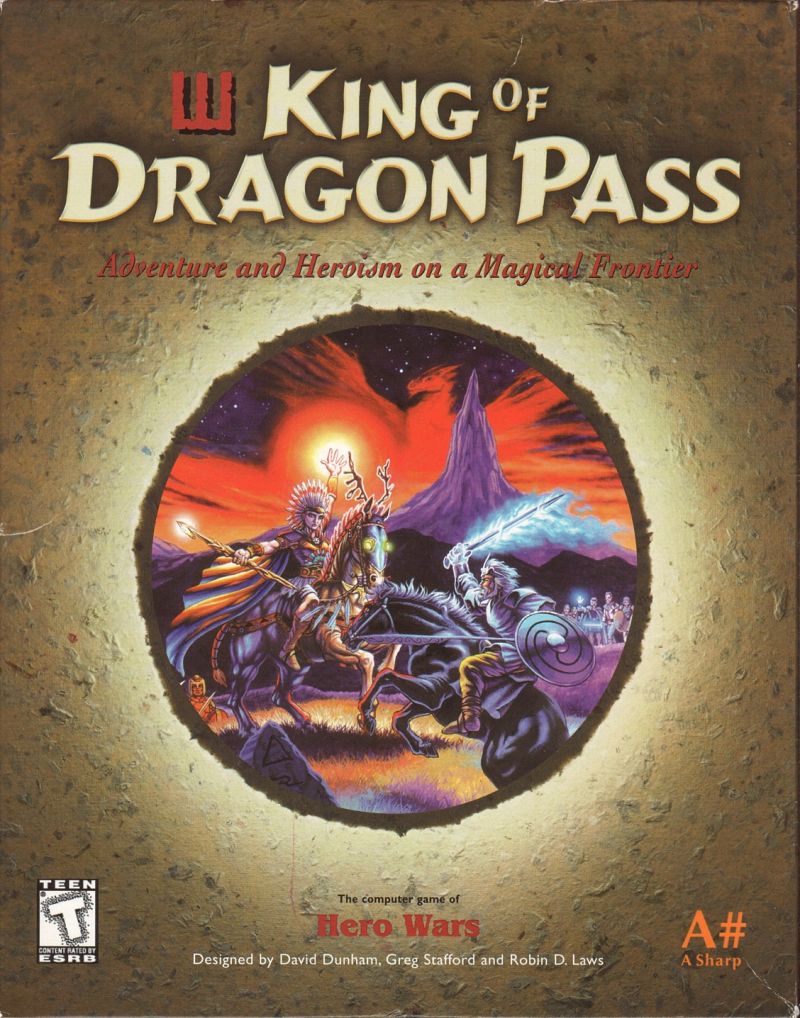
The PC version, that is. It’s part of the Steam Winter Sale, at -70%! You can even get it in a bundle with its sequel Six Ages.
RPGImaginings Plays Vasana’s SoloQuest
In case you’re too busy to play the SoloQuest yourself, but you can multitask enough to watch someone else play it, RPGImaginings has got you covered!
The video is part 1 of a series, and includes some introduction on RuneQuest, some commentary on BRP rules or the world of Glorantha, and so on.
“Stand Watch”, a Holiday Tale
Ian Cooper shared this nice holiday season story:
“Stand Watch” – that was Orlanth’s instruction to Rigsdal. At this time of year in Glorantha (the Winter Solstice falls on Fire Day, Illusion Week of Dark Season) the Heortlings look up at the Pole Star and think about him as the Night Watchman.
Sacred Time remains weeks away, when spring comes in Sea Season, but many Heortlings doubtless look forward to it, as Rigsdal stands guard, and they gather around the “first hearth’ that is dedicated to Elmal – the light in the darkness, shining atop Kero Fin. Perhaps they indulge in salted beef, pickles, and pass around clay jugs of cider and other winter foods.
So prayers to the Night Watchmen and Elmal, who watch over us all, whilst Orlanth and Ernalda are the underworld.
“Stand Watch”
Elsewhere on Arachne Solara’s Web
Not everything is about Glorantha, although most things are! Here are loosely relevant things that we found on the interwebs.
Some Old Egyptian Board Game

Above is a good reference for board games in ancient times! It dates back to the 4th or 3rd millenium BCE, in the Early Egyptian Dynastic Period.
Who Were the Phoenicians and Where to Find Them in Glorantha
Joerg decided to pop into the newsletter this week!
While much of the Phoenician history falls into the Iron Age, their beginnings lie in the Bronze Age. (But then, a lot of the same can be said about the Greeks.)
There are few surviving records written by Phoenician sources, as they were vilified by their antagonists – most prominently the Romans, whose struggle with the Phoenician-founded city-state then empire of Carthage was bitter and genocidal.
The Phoenicians provided one of the earliest transportation network not only along the (mostly southern and central) Mediterranean coasts, but also in the coastal Atlantic on both northern Africa and western Europe. They served as middlemen already to the Bronze Age Egyptians, and may have been responsible for providing the tobacco found in certain royal mummies.
The Quinpolic League of southern Seshnela and Tanisor resembles the Phoenicians somewhat in their de-centralized city-state approach and their reliance on naval trade, and the Waertagi- and Tanisoran-enforced exodus of the surviving remnants of their merchant navy and patrol duty mercenary fleet may be the kernel of a new development, as touched upon in Martin Helsdon’s Periplus of Southern Genertela which had been available on Facebook for a short while, and of which there are about two dozen fund-raiser hardcopies in circulation since Dragonmeet. Martin has posted a few art previews on Facebook, mythological representations of the Mirrorsea Ports of Rhigos and Durengard by Katrin Dirim.
The Maslo cities might be another such non-centralized thalassocracy, even though they have Hoom Jhis as the Dynast of Flanch. Half the Maslo catamarans may come from Elamle, possibly more as the Masloi there are in league with the Alryami and may receive purpose-grown tree trunks for immense dugout hulls.
The Vadeli naval empire prior to the disastrous loss of the Battle of Oenriko Rocks against the Masloi and what remains of it in the Vadeli enclaves in Umathela and Fonrit and their port cities in Jrustela is another Gloranthan thalassocracy which bears some similarity to the Phoenician one, especially since the Vadeli lack a central government or leader due to their caste restrictions. Rather than being accused of burning their firstborn to Baal Ammon, the Brown Vadeli are rumored to eat their children to maintain their immortality. But then, the Vadeli are objectively vile, by their own choice, or that of their ancestors few generations earlier, in the Gods War.
Finally, the Waertagi trading monopoly in the Western Seas bears some similarity to the role of the Phoenicians following the Bronze Age collapse in the Mediterranean.
Hanno the Navigator
The most famous Phoenician mariner probably was Hanno the Navigator, a fifth century BC explorer whose periplus only survives in a Greek translation, which did reach much of the West African coast, and which has the remarkable observation of seeing the sun cast shadows toward the south, something observable only a fair bit beyond the tropical (or at high northern latitudes). While disputed, his travels may have carried him all the way to Gabon.
Alongside St. Brendan and his Old Irish cognate, Hanno is one of the achtetypical explorers that both Waertag and Dormal have been drawing on.
The Habiru and King Idrimi
The penomenon of the Apiru or Habiru in the late Fertile Crescent Bronze Age is interesting as the composition of their forces has a lot in common with how Umath and after him Orlanth assembled his Storm Tribe around him. The name “the dirty” also applies to the Burtae, and the appearance of the Storm Peoples.
One Habiru leader was Idrimi, a disowned son of a king who made himself leader of a sizable contingent of the Habiru and leading them against numerous established cities. The story of many a Gloranthan hero fits this bill, like Prince Aamor mentioned in the Seshnela chapter of the Guide
Thank you for reading
That’s it for this week! Please contact us with any feedback, question, or news item we’ve missed!



One comment on “Journal of Runic Studies #28”